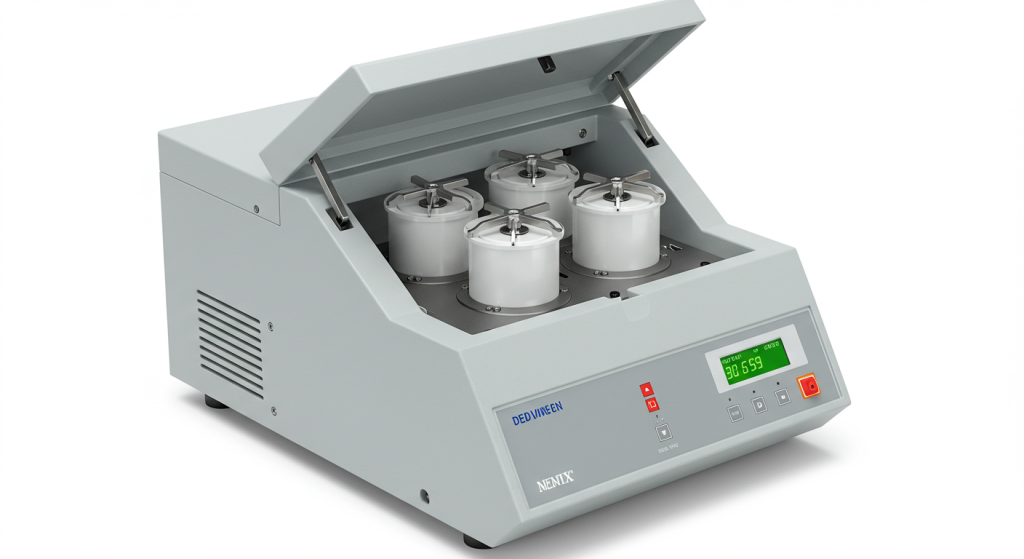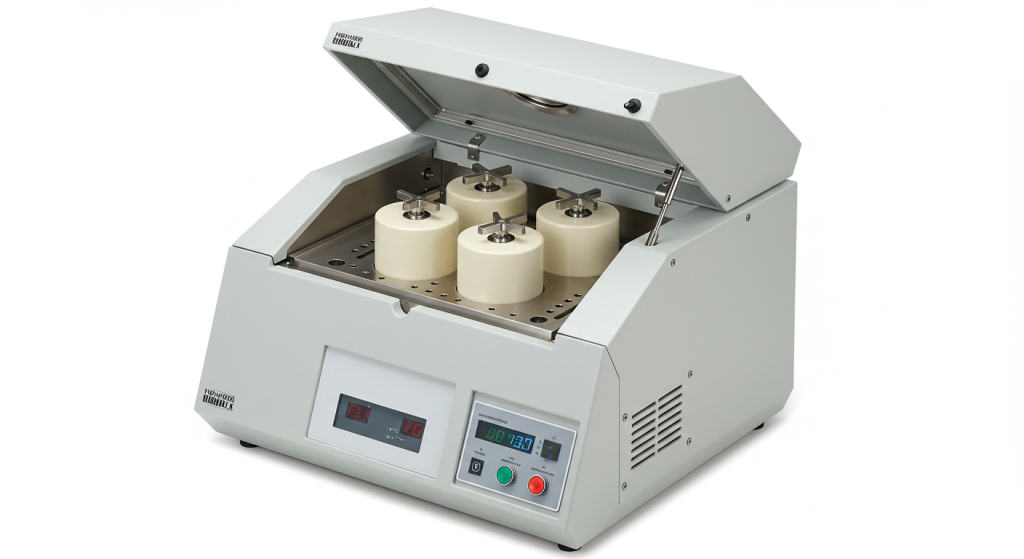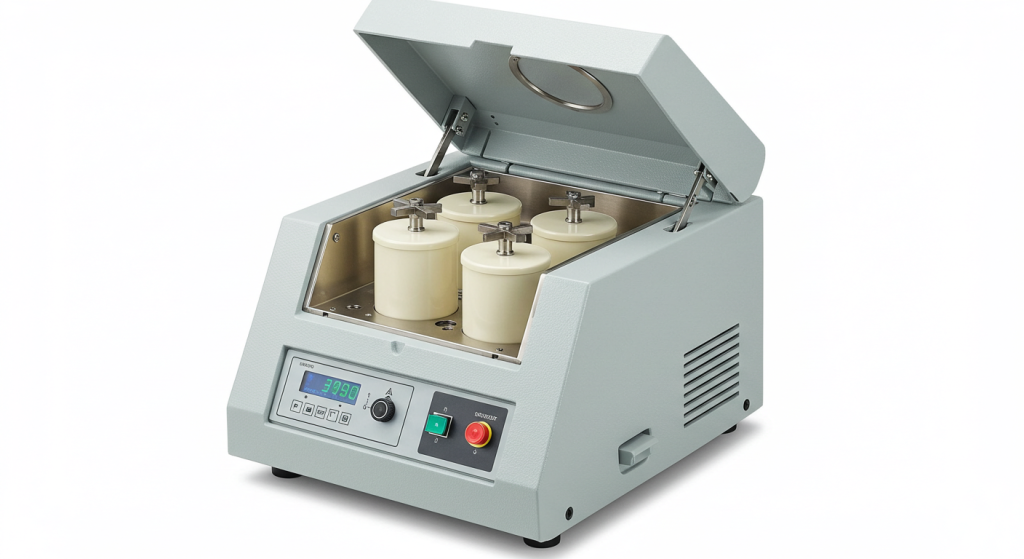The process of selecting the right equipment for your laboratory can be complex, and choosing a lab rolling ball mill is no exception. Understanding the various features, benefits, and limitations of different models is crucial for making an informed decision. When you’re diving into the world of material processing and particle size reduction, you’ll inevitably ask yourself questions about “How to buy lab rolling ball mill”. This detailed guide provides comprehensive insights to aid your decision-making process, ensuring you select the most suitable equipment for your specific needs. Moreover, considering the material of the jar, you might ask “Why to buy nylon roll ball mill jar?”, a question we’ll explore in depth in this article, alongside other critical aspects to consider.

Navigating the World of Rolling Ball Mills
Before diving into “How to buy lab rolling ball mill”, it is vital to have a solid understanding of what rolling ball mills are and how they differ from other milling equipment.
What is a Rolling Ball Mill?
A rolling ball mill, frequently called a jar mill, utilizes a rotating cylindrical container (jar) containing grinding media and the material to be processed. As the jar rotates on a set of rollers, the grinding media (balls) tumble and crush the material through impact and attrition. This method is effective for a wide variety of applications that require batch processing of solid materials. The speed, jar size, and grinding media are the main variables for controlling milling efficiency.
What is the difference between ball mill and roller mill?
While these terms are sometimes used interchangeably, it is important to clarify “What is the difference between ball mill and roller mill?”. The main difference lies in their primary function. A ball mill is a grinding device that uses balls as grinding media for particle size reduction, with the mill itself being the vessel in which the grinding occurs. A roller mill, on the other hand, is a machine using rollers to rotate or move the vessel (jar) in which grinding takes place. In a lab setting, roller mills are typically used to rotate jars containing balls, therefore are typically combined into a *rolling* ball mill. In industrial settings, roller mills may refer to multi-roll mills used for mixing and compounding. In short, a ball mill does the grinding, the roller mill provides the means to rotate the vessel.

How to Calculate Ball Mill Size?
The question of “How to calculate ball mill size?” is crucial for proper equipment selection. The appropriate mill size depends on the volume and particle size of the material you want to process. Factors to consider include the jar volume, filling ratio (how much material is needed in comparison to media) and rotational speed. Manufacturers often provide guidelines based on material characteristics and desired output. A detailed calculation involves determining the mill’s power requirement, media size, and total loading volume but this level of calculation is typically done when setting up large scale industrial ball mills. For lab ball mills the size is usually determined by the jar capacity and batch size.
What is the difference between a ball mill and a colloidal mill?
Understanding “What is the difference between a ball mill and a colloidal mill?” is essential for application-specific equipment selection. A ball mill, as discussed, uses grinding media to reduce particle size through impact and attrition. Colloidal mills, however, are primarily used to produce colloidal dispersions by mechanical shearing forces and are more about producing extremely fine emulsions. While both can reduce particle size, colloidal mills are typically used for liquid-based mixtures, while ball mills are typically used with dry solids or slurries.

Understanding “Why to buy nylon roll ball mill jar”
When evaluating “How to buy lab rolling ball mill” the material of the grinding jar is of paramount importance. One common choice that raises the question “Why to buy nylon roll ball mill jar?” is nylon. Nylon jars offer several advantages for lab-scale grinding applications:
- Chemical Resistance: Nylon is resistant to many chemicals, making it suitable for processing diverse materials, including those with some degree of chemical activity.
- Lightweight: Nylon jars are lighter than their metal or ceramic counterparts, facilitating easier handling and installation on the roller mill.
- Impact Resistance: Nylon is very resilient and impact resistant, which reduces the risk of damage or breakage during operation.
- Cost Effective: Nylon jars are less expensive than many other materials while maintaining the performance and stability of the milling process.
- Low Contamination: With its resistance to wear and chemical interactions, a nylon jar can help to minimize contamination of the ground material.
Therefore, choosing a nylon roll ball mill jar is often a smart choice for many laboratory applications, making it a viable solution for a range of milling requirements. When considering how to buy a lab rolling ball mill, keep the importance of the milling jar in mind.
Where to Buy Roll Ball Mill
Finding reliable suppliers is a critical aspect of “How to buy lab rolling ball mill”. The question of “Where to Buy Roll Ball Mill” is paramount. Here are several avenues to explore:
- Specialized Laboratory Equipment Suppliers: These are dedicated suppliers that focus on laboratory equipment and typically have a broad range of options, and good customer support. They are usually very knowledgeable about the machinery they sell.
- Online Marketplaces: Many online platforms offer a variety of ball mills from numerous suppliers. This can be a good way to compare prices, but carefully scrutinize suppliers based on their ratings, and ensure the unit you purchase meets your requirements.
- Direct from Manufacturers: You can contact manufacturers directly to discuss customization options or get specific details about their equipment.
- Scientific Equipment Auctions: Occasionally, you can find used but well-maintained laboratory equipment through auction platforms, often at a reduced cost.
When selecting where to purchase your roll ball mill, consider factors such as supplier reputation, warranty, after-sales support, and price. Always compare multiple options before making your decision. The best place to buy your roll ball mill should be one that suits your specific needs and budget.
Key Components of a Laboratory Rolling Ball Mill
Familiarizing yourself with the main components of a lab rolling ball mill helps in the selection process and ensures the best operation:
- Roller Unit: This is the base unit comprising parallel rotating rollers that rotate the grinding jars. The material the rollers are constructed from is important, with rubber and polyurethane rollers common choices.
- Grinding Jar: The cylindrical vessel that holds the sample and grinding media. As mentioned the material here can be glass, steel, ceramic, or nylon; the jar must be chemically inert to the material being processed.
- Grinding Media: The balls that impact and grind the material. Options include steel, ceramic (alumina, zirconia), glass, and other materials, with sizes ranging from a few millimeters to several centimeters.
- Drive System: This involves the motor, gears, and control systems that drive and manage the rotation of the rollers. Look for options with variable speed for better control over the milling process.
- Control Panel: Provides options for adjusting the rotational speed, time setting, and sometimes more complex operating cycles, ensuring accurate and consistent milling.
Applications of Laboratory Rolling Ball Mills
Laboratory rolling ball mills serve a variety of applications across numerous scientific and industrial sectors. Some of the common applications include:
- Material Synthesis: Creating new materials or composites through mechanical alloying and mixing.
- Particle Size Reduction: Grinding solids into fine powders for various applications.
- Sample Preparation: Creating homogenous samples for laboratory testing and analysis.
- Chemical Reactions: Assisting in chemical reactions that require mechanical forces.
- Pharmaceutical Research: Milling and mixing active pharmaceutical ingredients (APIs) and excipients.
- Ceramics and Glass: Pulverizing raw materials to produce fine powders for ceramic and glass production.
Factors to Consider When Choosing a Lab Rolling Ball Mill
When evaluating “How to buy lab rolling ball mill,” consider the following important factors:
- Material Properties: Consider the hardness, abrasiveness, and chemical reactivity of the materials you intend to process. Abrasive materials may require harder grinding media or more robust jar materials.
- Capacity and Throughput: Select a mill with a jar size suitable for the quantities of materials you process. The required throughput depends on the speed and duration of your grinding cycle.
- Grinding Media: Choosing the proper size and material of the grinding media is important for efficient milling. Some media materials can react to certain chemical processes and therefore should be chosen carefully. “What are the best balls for a ball mill?” is a very specific question that must be answered case-by-case.
- Variable Speed: A unit that can control the rotational speed provides greater control over the milling process and better optimization for different applications.
- Digital Controls: Modern systems come with digital interfaces and programmable functions, which can be especially helpful for setting repeatable parameters.
- Safety Features: Look for features such as emergency stop buttons and enclosures to ensure safe operation.
- Ease of Cleaning and Maintenance: The mill should be easy to disassemble, clean, and maintain to minimize downtime and prevent cross-contamination.
- Budget and Cost-Effectiveness: Consider both the initial purchase price and the running and maintenance costs. Consider whether buying used “Ball Mill for sale” is an option, if you have a limited budget.
Types of Laboratory Ball Mills
It’s worth exploring the different kinds of ball mills to have a broader understanding when you consider “How to buy lab rolling ball mill”.
Planetary Ball Mill
As stated before, a “Planetary Ball Mill for laboratory” uses a different system to achieve much more aggressive grinding action. The jars counter-rotate while on a rotating disc, which results in significantly higher grinding forces. These mills are often used for ultrafine particle size reduction and are excellent for nano-scale milling.
Vibratory Ball Mill
Vibratory ball mills use high-frequency vibrations to cause the grinding media to impact the material being milled. These mills can grind material rapidly to fine and ultra-fine particle size, and are often used for laboratory research and sample prep.
Jar Rolling Mill
This is the simplest rolling mill, where jars with the media and materials are placed onto rotating rollers. These types of mills are best used for milling moderate size batches of materials.
The Importance of Ball Mill Media
The effectiveness of a ball mill is highly dependent on the grinding media used. Some commonly used media materials and sizes are discussed below.
What are the best balls for a ball mill?
Answering “What are the best balls for a ball mill?” involves considering several factors, including the material of the sample, the desired level of fineness, and the level of contamination you want to avoid. Here’s a look at common options:
- Steel: Steel balls are durable and cost-effective, suitable for many applications. They may, however, cause contamination if grinding sensitive materials.
- Ceramic: Ceramic media (e.g., alumina, zirconia) are very hard, have a high chemical inertness and are excellent for reducing contamination, and are very good for fine grinding.
- Glass: Glass balls are inert and good for applications that require minimal contamination, although they may be less robust than some other media.
- Tungsten Carbide: Tungsten carbide provides superior hardness, and is a good option for highly abrasive materials. This is an expensive option, however.
- Nylon/PU: This material is durable and shock absorbent, and great for when a softer milling action is needed. These materials also reduce contamination and are ideal for mixing and gentle dispersion.
The size of the grinding balls also matters. Smaller balls achieve finer particle sizes, while larger balls are better for coarser grinding or if the starting material is large. A range of sizes is sometimes used to provide a mix of milling action. When you consider “How to buy lab rolling ball mill” always factor in the impact of ball mill media choice on the application. The material, size, and shape of media directly affect the efficiency and outcome of the grinding process. You may need different media sizes for different samples.
Understanding “Ball milling services” and “Ball milling machine”
When evaluating the options available for “How to buy lab rolling ball mill,” two other related topics often arise: “Ball milling services” and “Ball milling machine.” Understanding these two concepts enhances the decision-making process.
Ball Milling Services
These are professional services where third-party providers offer ball milling of materials to other businesses or research entities. If you only occasionally need milling services or don’t want to invest in the equipment directly, these services can be a valuable option. The service typically encompasses the complete milling procedure, from material preparation and grinding to analysis, providing a convenient solution for a range of processing needs. There are many different service companies that can provide you with these services, and often, you can specify the material for milling, the type of jar and grinding media, and the size and shape of the output you need.
Ball Milling Machine
The term “Ball milling machine” broadly refers to the actual equipment used for ball milling, whether it is a simple jar mill, a planetary mill, or an industrial-scale mill. When you choose to invest directly in the equipment, you can have greater control over the milling process and can customize your procedures to your specific requirements.
Maintenance and Troubleshooting
Proper maintenance is crucial for the longevity and efficiency of your laboratory rolling ball mill. Regular maintenance should include:
- Regular Cleaning: Clean the grinding jars, rollers, and media after every use to prevent cross-contamination and buildup of residues.
- Lubrication: Lubricate all moving parts in accordance with the manufacturer’s recommendations.
- Inspection: Regularly inspect all components for wear and tear. Especially the rollers and jar for signs of wear.
- Calibration: Ensure that the speed control is accurate to maintain consistent and repeatable outcomes.
Common troubleshooting issues include uneven grinding, excessive noise, or a malfunctioning drive system. Consulting the manufacturer’s manual and performing regular maintenance will resolve many issues. If you have a more complicated issue, it’s best to seek help from the manufacturer or qualified technicians.
Conclusion
The decision on “How to buy lab rolling ball mill” is an important one that requires careful planning and consideration of all available options. By thoroughly understanding the requirements of your application, you will be able to choose the right equipment. The benefits of nylon jars (“Why to buy nylon roll ball mill jar?”) can help you choose the correct jar type, and a strategic approach to sourcing (“Where to Buy Roll Ball Mill”) will help you find the correct equipment. By considering all the important factors related to equipment selection, grinding media, application needs, and long-term maintenance, you will ultimately be able to make the most informed decision. When you fully understand the various aspects of the rolling ball mill system, you can select a laboratory ball mill that will provide many years of reliable and consistent results.
